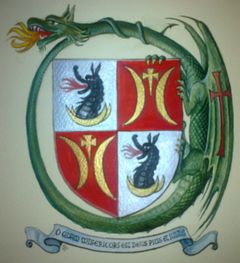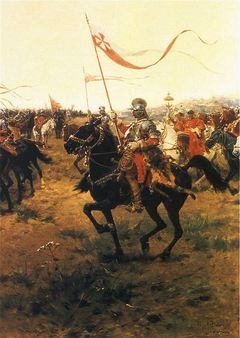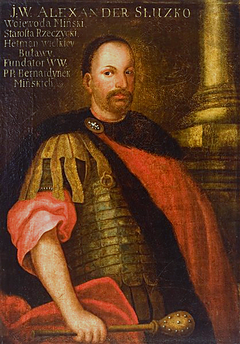Hall of Fame and Remembrance: Różnice pomiędzy wersjami
| Linia 21: | Linia 21: | ||
* '''[http://www.youtube.com/watch?v=AyJdeSslnys&feature=channel&list=UL Film]''' | * '''[http://www.youtube.com/watch?v=AyJdeSslnys&feature=channel&list=UL Film]''' | ||
| − | ==''' | + | =='''[[Mościc de Magni Kozmin]]'''== |
| − | '''[[Mościc de Magni Kozmin]]''' – the Duke of Poznań 1242–1252, owner of the towns of Rzeszow and Dynow and several other properties, created the Clan of Ostoja. During his time, the battle cry ''Ostoja'' become also a name of Mościc family ancient sign that | + | '''[[Mościc de Magni Kozmin]]''' – the Duke of Poznań 1242–1252, owner of the towns of Rzeszow and Dynow and several other properties, created the Clan of Ostoja. During his time, the battle cry ''Ostoja'' become also a name of Mościc family ancient sign that transferred into a Coat of Arms that have been given to all Knights that served under the command of Mościc's past generations. The elite group of Knights become united Clan of Ostoja. |
==Halina de Krepy 1270== | ==Halina de Krepy 1270== | ||
Wersja z 12:09, 28 paź 2012
There are many to remember and there are many of Ostoja's that served Poland in exceptional way. Each Ostoja family have their own heroes, here below are those that we all should remember as they represent all the Clan of Ostoja was in the past and will be in the future.
Husaria
"Heavy hussars of the Polish-Lithuanian Commonwealth" - Pride of Poland and the Commonwealth, the husaria banners or companies were considered the elite of the Polish-Lithuanian Commonwealth cavalry.
They were widely regarded as the most powerful cavalry formation in the world. Polish Hussars were undefeated in battle for over 100 years often against forces sometimes 5 times bigger. Ostoja's participated in all those battles and also saved Vienna from the Ottoman's in 1683. In many cases, Ostoja's where the commanders of elite Hussar unites being Rittmeister's, which was the most honorable and respected position in Polish-Lithuanian army in the history.
In the battles of Lubiszew in 1577, Byczyna (1588), Kokenhausen (1601), Kircholm (1605), Kłuszyn (1610), Chocim (1621), Martynów (1624), Trzciana (1629), Ochmatów (1644), Beresteczko (1651), Połonka (1660), Cudnów (1660), Chocim (1673), and Lwów (1675), Vienna (1683), Párkány (1683) the Polish-Lithuanian hussars proved to be the decisive factor often against overwhelming odds. For instance, in the Battle of Kluszyn during the Polish-Muscovite War the Russians outnumbered the Commonwealth army 5 to 1, yet were heavily defeated.
In the battle of Żółte Wody, the 1500 man strong army of Stefan Potocki containing less than 200 hussars faced 12.000 man strong army of Chmielnicki and due to heroic battle of the hussars, amry could hold possition in 18 days, although attacked 24 hours a day. Due to error of hetman Potocki, Stefan Potocki's father, main forces did never come to rescue in time. In some publications or films it is written that polish hussars where heavily defeated in this battle. Nothing could be more wrong!
The Hussar banner's was elite force of the nobility of the Commomwelath and the place in those formations was almost always reserved to the nobility. However, in Battle of Vienna, several persons of non-noble origin where admitted to join the force as they where professionally trained for this kind of mission. To serve in Husaria was therefore also a way to receive nobility.
In 1776, the duties and traditions of the Hussar's were passed on to the Uhlans by a parliamentary decree.
Mościc de Magni Kozmin
Mościc de Magni Kozmin – the Duke of Poznań 1242–1252, owner of the towns of Rzeszow and Dynow and several other properties, created the Clan of Ostoja. During his time, the battle cry Ostoja become also a name of Mościc family ancient sign that transferred into a Coat of Arms that have been given to all Knights that served under the command of Mościc's past generations. The elite group of Knights become united Clan of Ostoja.
Halina de Krepy 1270
Legendary doughter to castellan Piotr Krepy that was defeated and killed by tatar's during their invation. Halina succeded to fool and trap tatars in their next attempt to burn down Sandomierz and, sacrifying own life dor the Town and people.
Jakusz de Błociszewo
The Duke of av Lviv 1370, created great line of the Clan of Ostoja.
Abel Biel de Bleszno
The Lord of Regality of Inowrocław och Krzepice and comes urbis of Wielun. Legendary Knight in the Castel of Bleszno.
Stibor de Stiboricz
Greatest Lord of Ostoja in the medieval time, the Duke of Transylvania, Palatine of Trencin, Nitra and Bratislava, Lord of 31 castles and around 300 propeirties, alltogether half of western Slovakia, Lord and owner of whole 406 km long river Vah. Great general and diplomat, saved Poland during the time of war with Teutonic Knights. Richest and most influential persom in the history of the CLan of Ostoja and also one of the richest and most influential persons in Polish history.
Stibor de Poniec
Together with Duke Jan de Jani of Ostoja and Duke Nikolaus Szarlejski de Stiboricz formed coalition to win the stronghold of Malbork (Marieburg) for Poland. Great diplomat, Lord of Greater Poland, Lord of Regality of Malbork.
Jan Jański de Turze (Jan de Jani)
The Duke of Gdańsk and Pomerania 1454, married to sister of Nikolaus Szarlejski de Stiboricz and joined the Clan of Ostoja. Formed coalition with Nikolaus Szarlejski de Stiboricz and Stibor the Poniec.
Nikolaus Szarlejski de Stiboricz (1400–1457)
In coalition with Jan de Jani and Stibor de Poniec in order to break down the dominance of the Teutonic knights in Pomerania. Duke of Inowrocław, Kujavien and Brest, Lord of Regality of Bydgoszcz, Gniewkowo and many others. Supreeme commander of Polish army in Prussia. Count of Tuchola adn Brodnica. The last from main line of the Mościc dynasty.
Nikolaus Kreza de Zawady
From 1486 owner of legengary Bobolice stronghold that remained in the hands of the family until year 1625.
Knights and heroes
Jerzy Saczkowicz Raczko-
Distinguished and honorable Knight from Puszyce, judge of Belsk (1514-1533), participated in the campagne against tatars in Kleck 1606 together with Jan Radziwiłł. Sectretary of the King Zygmunt Stary I to the end of 1533.
Kacper Karliński (–1590) - the Hero of Olsztyn
Lord of Regality of Olsztyn 1563–1587, widely known for heroic defence of the Town year 1587.
The Princes Szyszkowski of Ostoja
Marcin Szyszkowski (1554–1630)
Bishop of Kraków, Prins of Siewierz - second in dignity in the Commonwealth after the King, as Prince of Siewierz he served the Pope and as Bishop of Krakow he served Poland. One of the most powerful persons at that time in the Commonwealth.
Mikołaj Szyszkowski (1590–1643)
Biskop and prins of Warmia (Ermland).
Kazimierz Siemienowicz (1600–1651)
General of artilery, engineer. Know in Europe for Artis Magnae Artilleriae that during 200 years was used as manual in all of the Europe.
Jan Stachurski
Major General of Royal army 1664
Elisabeth Słuszka (1619–1671)
Origin from one of the greatest and wealthiest families of Lithuania, most powerfull and richest woman in the Commonwealth, one of the most powerful women in Europe then and in the history. One of the reasons of the Polsih-Swedish war commonly named "Potop" - the Deluge.
Josef Bogusław Sluszka (1652–1701)
Hetman, castellan av Troki och Vilnius.
Florian Hrebnicki (1684–1762)
Archbiship of Polotsk.
Józef Siemoński
General of the Kościuszko forces in Sandomierz.
Bar Confederation
Franciszek Ksawery Ścibor-Bogusławski (1713–1796) - Rittmeister of Bar-konfederationen and Michał Ostaszewski (1720–1816) that Organized the Bar-konfederationen in Lower Carpathian region.
Generals of Royal Army in the partition of Commonwealth
Tadeusz Błociszewski (–1803) and Antoni Baranowski (1760–1821) - Major Generals of Royal Army during the partition of the Commonwealth
Ignacy Ścibor Marchocki (1755–1827
Creator of independent Minkowce country
November Uprising
Stanisław Ścibor-Bogusławski - major w 13 pułku piechoty liniowej podczas powstania listopadowego. Odznaczony Krzyżem Kawalerskim Orderu Virtuti Militari
January Uprising
Jan Czeczot (1796–1847)
Famouse poet and etnograph in Belarus
Kacper Kotkowski (1814–1875)
The Priest that organized the Uprising in Sandomierz against Russian Empire.
Professors of Jagiellonian University
Maciej Józef Brodowicz (1790-1885)
Medicine professor
Władysław Chotkowski (1843–1926)
Professor and master of Jagellonian University
Tadeusz Ostaszewski (1918–2003)
Professor of art in Jagellonien University in Krakow
Stanisław Błociszewski(1804-1888)
Major of Polish Uprising army - participated in November Uprising and in Great Poland Uprising. Received the Gold Cross of Virtuti Militari. All three son's of Błociszewski took part in the January Uprising year 1863. Read more - Czytaj więcej
Ladies of Ostaszewski family during Uprisings
Łukasz Solecki (1827–1900)
Bishop of Przemyśl and professor in University of Lviv
Mieczysław Karłowicz (1876–1909)
Composer and dirigent
Zygmunt Czechowicz (1831–1907)
Initiated general strike and national Uprising in Belarus.
Witold Ścibor-Rylski (1871-1926)
Army General that fought for the independence of Poland.
Włodzimierz Zagórski (1882–1927)
General of Polishh Airforces
Adam Ostaszewski (1860–1934)
Widely known as Leonardo from Wzdow, inventor
Katyn - generals of Ostoja
Bronisław Bohatyrewicz(1870–1940) - military commander and a general of the Polish Army. Murdered in Katyn. Bohatyrewicz was one of the two Generals whose bodies were identified during the 1943 exhumation. Kazimierz Suchcicki of Ostoja (1882-1940) was also general that died in Katyn same year.Read more - Czytaj więcej
Słoński brothers during WW2
Bracia Słońscy - Słoński brothers, officers of RAF (Royal Airforce). Three brothers that all where shot down and killed during WW2 in service for Poland and fridom.
Uniechowski systers during WW2
Karola Uniechowska(1904–1955) - volontare, medicine doctor during WW2, participated in the Battle of Monte Cassino and her syster Zofia Uniechowska (1909–1993) - received order of Virtuti Militari for conspiration agains nazi goverment in Poland.
Zofia Ścibor-Rylski
Master spy during WW2 under the pseudonim Marie Springer, her work led to localisation of German battleship Tirpitz.
Adam Hrebnicki-Doktorowicz (1857–1941)
Professor and scienties for development of agriculture.
Casimir Zagorski (1883–1944)
Pioneer and photographer, widely known in the world for exceptional documentation of lost african tribes.
Zygmund Ignacy Rylski (1898-1945)
Legendary Major Hańcza
Wacław Krzywiec (1908–1956)
Legendary Commander of legendary battleship ORP Błyskawica
Maxym Rylski, (1895–1969)
Widely known poet in Ukraina, loved by the people, national monuments in Kiev.
Bronisław Hełczyński (1890–1978)
Professor in Oxford, foreign minister of Polish goverment in exile (London).
Tadeusz Sędzimir (1894–1989)
Widely, worldwide recognized inventor
Joseph Stanislaus Ostoja-Kotkowski (1922–1994)
Famous artist using laster technics. Known worldwide
Adam Kozłowiecki (1911–2007)
Archbishop of Lusaka, Zambia
Warsaw Uprising during WW2
Zbigniew Ścibor Rylski (born 1917) - General, officer of Warsaw Uprising during WW2 and Andrzej Zagórski (1926–2007) that wrote around 250 books about the resistance during WW2, officer in Polsish army (AK)


